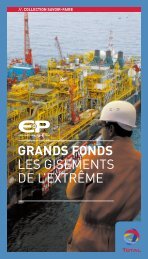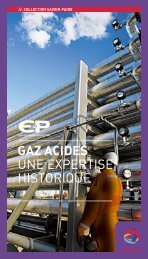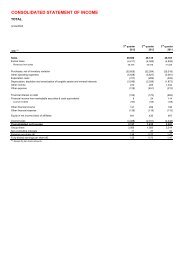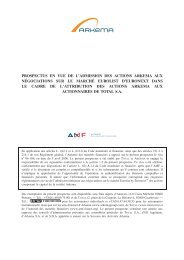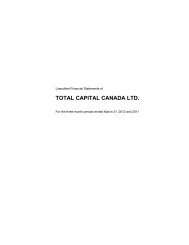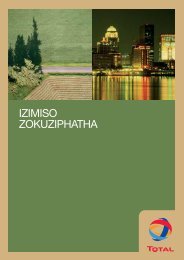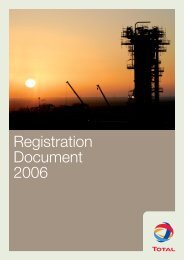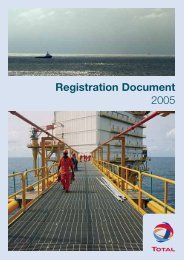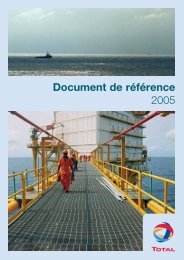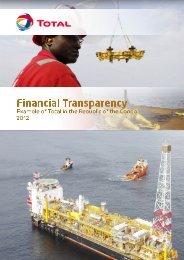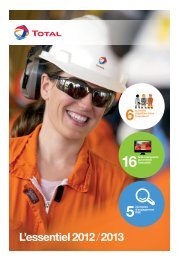Deepwater development The ultimate frontier - Total.com
Deepwater development The ultimate frontier - Total.com
Deepwater development The ultimate frontier - Total.com
You also want an ePaper? Increase the reach of your titles
YUMPU automatically turns print PDFs into web optimized ePapers that Google loves.
. the KNOW-hOW series<br />
ExPLOrATiOn & PrOducTiOn<br />
GraNds deePWater fONds<br />
deVeLOPMeNt<br />
LEs gisEmEnts<br />
thE dE L’ExtrêmE uLtimatE<br />
frontiEr
. CONteNts<br />
deePWater<br />
deVeLOPMeNt<br />
<strong>The</strong> ulTimaTe<br />
fronTier<br />
s s s<br />
Page 3 fOreWOrd<br />
Page 4 CONtext<br />
deepwater resources will contribute<br />
to the replacement of world oil and gas reserves.<br />
Page 6 ChaLLeNGes<br />
Constant innovation building on the group’s many<br />
deepwater achievements forges total’s leading edge.<br />
Page 8 exPertise<br />
Committed to extracting value from the ocean<br />
depths while maintaining a clear focus on safety and<br />
the environment, total has furthered progress in<br />
deepwater production with a succession of large-scale<br />
breakthroughs and daring <strong>development</strong> schemes.<br />
P. 10 Learning to understand an uncharted <strong>frontier</strong><br />
P. 12 deciphering <strong>com</strong>plex deepwater systems<br />
P. 16 developing deep-sea giants<br />
P. 20 dalia, a new deepwater reference<br />
P. 22 New challenges in the making<br />
Page 26 GrOuP<br />
total worlwide in 2006.<br />
gulf of guinea, angola.
. fOreWOrd<br />
extending the life<br />
of hydrocarbon resources<br />
<strong>Total</strong>’s Exploration & Production branch<br />
continually pushes oil and gas production<br />
to new limits. Drawing on the <strong>com</strong>plete<br />
integration of its multidisciplinary<br />
expertise, the Group has honed a<br />
capacity for innovation that has secured<br />
its rank among the frontrunners in the<br />
technologies strategic to the future<br />
of the energy industry.<br />
<strong>Total</strong>’s Exploration & Production branch<br />
is involved in all of the industry’s key<br />
technological challenges, namely,<br />
extra-heavy crude oil, ultra-deepwater<br />
offshore, sour gas, hydrocarbon<br />
resources that are deeply buried (highpressure/high-temperature)<br />
or difficult to<br />
produce because they are in “tight sand”<br />
reservoirs. At the same time, the Group<br />
“Innovation will be the main<br />
driver of sustainable growth<br />
in our production.”<br />
is inventing the tools and techniques<br />
required to access residual reserves<br />
on conventional acreage.<br />
Relying on synergies with other<br />
Group branches operating in the fields<br />
of gas and power, refining and marketing<br />
and petrochemicals, the E&P branch<br />
proposes technological solutions<br />
that cover the <strong>com</strong>plete value chain<br />
from production to finished products<br />
and/or markets.
04<br />
DeePWaTer DeVeloPmenT<br />
s<br />
1. luanda, angola.<br />
Deep offshore<br />
potential<br />
Assuming that nearly half of the<br />
world’s deepwater reserves have<br />
already been discovered, <strong>ultimate</strong><br />
deepwater potential is currently<br />
estimated to be on the order of<br />
100 Bboe*. Although this volume<br />
represents but a small portion<br />
of total remaining reserves, it is<br />
equivalent to two years of current<br />
world production, or to the<br />
aggregate of all proven reserves<br />
of the world’s seven largest oil<br />
<strong>com</strong>panies. In other words, for the<br />
few operators leading the way in<br />
the discovery and <strong>development</strong><br />
of these challenging resources,<br />
the deep offshore promises<br />
significant opportunities.<br />
* Billion barrels of oil equivalent.<br />
//. CONtext<br />
PrOMisiNG<br />
PoTenTial for<br />
<strong>The</strong> fuTure<br />
s s s<br />
<strong>Deepwater</strong> resources will contribute to the replacement<br />
of world oil and gas reserves.<br />
offshore resources have be<strong>com</strong>e essential contributors to world energy<br />
supply, accounting for nearly 30% of hydrocarbon liquids production.<br />
in the period from 1999 to 2003, 70% of the new oil and condensate<br />
discoveries were offshore finds, raising the offshore share in world<br />
reserves to 23% for liquids, and 42% for gas*. <strong>The</strong>se figures, which stand<br />
for very significant volumes, refer mainly to the “conventional offshore”<br />
with water depths to 500 meters. reserves in deeper waters make up<br />
a much smaller share in the world total: 4% for liquids, 3% for gas.<br />
however, a number of deepwater “hot spots” – notably in africa, north<br />
america and South america – have accounted for more than 75%<br />
of the economically producible volumes identified in recent years.<br />
With major oil and gas discoveries be<strong>com</strong>ing increasingly rare in the<br />
conventional offshore (water depths to 500 meters), oil <strong>com</strong>panies are<br />
now seeking reserve replacement in the deep (500 to 1,500 meters)<br />
and ultra-deep (deeper than 1,500 meters) offshore. <strong>The</strong> main<br />
high-potential areas have been pinpointed – off the sprawling estuaries<br />
of the world’s major rivers, notably in the Gulf of mexico, the Gulf of<br />
Guinea and the Brazilian offshore – but only a few oil <strong>com</strong>panies master<br />
the techniques needed to develop them efficiently. long considered<br />
not economically viable, the production of these resources has be<strong>com</strong>e<br />
reality through many technological advances and innovations in recent<br />
years, from time-lapse seismic and high-precision drilling to subsea<br />
equipment and surface installations specifically developed for these<br />
extreme challenges. <strong>The</strong> industry has blazed a trail of progress since<br />
the 1990s. Spearheading this progress with large-scale pioneering<br />
projects, <strong>Total</strong> has established itself as a global leader in the conquest<br />
of the deep seas. nnn<br />
* Source: IFP (French Petroleum Institute).
06<br />
DeePWaTer DeVeloPmenT<br />
s<br />
<strong>Total</strong> continues to consolidate<br />
its leadership in nigeria, with the<br />
akpo and usan field <strong>development</strong>s.<br />
<strong>The</strong> triumphs of Block 17<br />
<strong>The</strong> Group has scored spectacular<br />
exploration success in Angola’s<br />
deepwater Block 17, with some<br />
fifteen discoveries since 1996.<br />
<strong>The</strong> <strong>development</strong> of these fields<br />
is currently focusing on three<br />
production zones:<br />
– Girassol has included<br />
production from Jasmim since<br />
November 2003, Rosa will be<br />
//. ChaLLeNGes<br />
at the fOrefrONt<br />
of <strong>The</strong> inDuSTry<br />
s s s<br />
Constant innovation building on the Group’s many<br />
deepwater achievements forges <strong>Total</strong>’s leading edge.<br />
angola’s Girassol field lies in water depths of 1,400 meters. <strong>Total</strong><br />
brought this deepwater giant on stream at end 2001, signaling the<br />
Group’s expertise in the mastery of such <strong>com</strong>plex projects as well as the<br />
technological challenges of deepwater production. <strong>The</strong>se feats earned<br />
<strong>Total</strong> the industry’s highest awards for excellence. in 2003, the Jasmim<br />
field was tied back to the Girassol fPSo (floating Production, Storage<br />
and offloading vessel). <strong>The</strong> success of Girassol and the Jasmim satellite<br />
<strong>development</strong> paved the way for other ambitious projects like Dalia, the<br />
new benchmark for the <strong>development</strong> of angola’s deep offshore. Dalia<br />
came on stream at end 2006 and should reach a plateau production<br />
level of 240,000 b/d in 2007. Building on this know-how, the Group has<br />
scored further breakthroughs in angola’s Block 17 but also in the Gulf of<br />
mexico, with matterhorn and Canyon express. To achieve these multiple<br />
victories, <strong>Total</strong> developed new-generation, giant fPSo vessels, special<br />
riser towers and flexible risers, purpose-designed subsea installations<br />
and “smart <strong>com</strong>pletions.” <strong>The</strong> Group is now proving its leadership<br />
through a continuing series of deepwater and ultra-deepwater<br />
<strong>development</strong>s in Congo (moho Bilondo), angola (Pazflor, CloV, and<br />
Block 32), and nigeria (akpo and usan).<br />
Drawing on the <strong>com</strong>prehensive expertise of its r&D teams and its<br />
culture of constant innovation, <strong>Total</strong> is over<strong>com</strong>ing technological barriers<br />
to implement increasingly <strong>com</strong>plex <strong>development</strong>s and optimize project<br />
profitability. major research objectives are “all-electric” subsea systems<br />
and subsea gas/liquids separators to boost recovery rates, the aim<br />
being to have the deep offshore contribute 10% to Group-operated oil<br />
production by 2008. nnn<br />
tied into the system in 2007;<br />
– Dalia is in the process of<br />
installation, and first oil was<br />
achieved on December 13, 2006;<br />
– Pazflor, now in the front-end<br />
study phase, will pool production<br />
from Perpetua, Zinia, Hortensia,<br />
and Acacia.<br />
By 2011, these three zones<br />
together are expected to produce<br />
700,000 b/d. A fourth production<br />
zone is under consideration<br />
at present, with the construction<br />
of a stand-alone FPSO for the<br />
<strong>development</strong> of Cravo, Lirio,<br />
Orquidea, and Violeta (CLOV).<br />
Plans call for these fields<br />
to be successively tied back,<br />
guaranteeing a stable<br />
production level.
Rio Grande<br />
<br />
deepwater production<br />
deepwater <strong>development</strong><br />
<strong>Deepwater</strong> fields operated by <strong>Total</strong><br />
field: 1. Matterhorn<br />
total’s interest: 100 %<br />
technical solution: tLP<br />
Plateau production: 25,000 b/d<br />
first oil: 2003<br />
Les champs du bloc 17<br />
<br />
2. Gotcha<br />
70% – fEEd *<br />
3. akpo<br />
24% – fPso – 225,000 boe/d – 2008<br />
4. usan<br />
20% – fPso – 150,000 boe/d – 2010<br />
5. Moho Bilondo<br />
53.5% – fPu – 90,000 b/d – 2008<br />
6. MtPs<br />
40% – fEEd<br />
7. Block 32<br />
30% – fEEd<br />
8. CLOV<br />
40% – fEEd<br />
<strong>The</strong> 15 discoveries and their production capacity on Block 17, Angola<br />
07<br />
9. Girassol/Jasmim/rosa<br />
40% – fPso – 250,000 b/d – 2007<br />
10. dalia<br />
40% – fPso – 240,000 b/d – 2006<br />
11. Pazflor<br />
40% – fPso – 200,000 b/d – 2010<br />
* Front-end engineering design.
. exPertise<br />
CONqueriNG<br />
thE uLtra-dEEP<br />
offshorE<br />
s s s<br />
in the late 1990s, more and more discoveries were made<br />
in ultra-deep waters. huge finds in key areas set off<br />
a new momentum that stimulated major r&d investments.<br />
With breakthroughs that secured the success of Girassol<br />
and dalia (angola) then Canyon express (Gulf of Mexico)<br />
in 2,200 meters of water, total demonstrated its capacities<br />
to continue pushing back the limits of possibility.
10<br />
DeePWaTer DeVeloPmenT<br />
s<br />
Better conservation<br />
through better<br />
understanding<br />
<strong>The</strong> Zaiango program launched<br />
in 1997 revealed two distinct<br />
and distinctive types of deep-sea<br />
benthic ecosystems: detrital<br />
ecosystems feeding on surface<br />
primary production and<br />
nutrients carried by the Congo<br />
River, and chemosynthetic<br />
ecosystems associated with<br />
cold seeps and characterized<br />
by specific fauna. <strong>The</strong> program<br />
also permitted in situ testing<br />
of the response of these<br />
ecosystems to disruptions<br />
related to oil activities.<br />
//. exPertise<br />
LearNiNG<br />
to undErstand<br />
an unChartEd<br />
frontiEr<br />
s s s<br />
until the end of the 20th century, deep continental<br />
margins had largely remained unexplored. <strong>Total</strong>’s<br />
involvement in deepwater exploration has contributed to<br />
better understanding of these <strong>frontier</strong> environments<br />
and their delicate ecological balance.<br />
oceans cover 360 million square kilometers of the earth’s surface.<br />
yet only a minute part of this vast area is relatively accessible and well<br />
documented: the continental shelves in shallow seas. When <strong>com</strong>panies decided<br />
to move into deeper waters, oil exploration became a true opportunity for<br />
scientific discovery. for <strong>Total</strong>, to meet the challenges of deepwater production<br />
in accordance with the Group’s environmental values, the first step was to<br />
expand its knowledge of these deep seas – the world’s last unexplored <strong>frontier</strong>s.<br />
in the late 1990s, <strong>Total</strong> launched two large-scale partnership programs with<br />
the french marine research institute ifremer to explore deepwater<br />
geological systems as well as benthic ecosystems.<br />
ZaiaNGO: MaPPiNG the dePths Of the GuLf<br />
Of GuiNea<br />
<strong>The</strong> Zaiango Project carried out between 1998 and 2001 involved<br />
extensive surveys of a 200,000-square-kilometer area in the Gulf of<br />
Guinea, offshore Zaire, angola and Congo (hence the acronym Zaiango).<br />
<strong>The</strong> focus of the different campaigns was both geological (studies of the<br />
turbidite system of the deep submarine fan, analysis of sediment<br />
instabilities) and bio-environmental (studies to enhance understanding<br />
of the benthic ecosystems). in cooperation with ifremer, some 4,200 line<br />
kilometers of high resolution (hr) 2D seismic profiles were acquired in<br />
water depths that in some parts exceeded 4,000 meters. <strong>The</strong> images<br />
obtained served to establish the first maps of the seafloor in this area,<br />
notably of the submarine fan of the Congo river, which was studied by<br />
means of geological cross-sections and samples. <strong>The</strong> wealth of data<br />
collected gave insight into the formation mechanisms involved in<br />
turbidite systems. Data also provided clues as to the sequential history<br />
of the submarine fan, and advanced understanding of ancient reservoirs,<br />
formed through the same processes of sedimentation, thus helping to<br />
pinpoint the most promising areas.<br />
BiOZaire: eNhaNCiNG uNderstaNdiNG<br />
Of deeP-sea eCOsysteMs<br />
in addition to Zaiango, <strong>Total</strong> and ifremer launched another project, the<br />
Biozaire cruise, in 1999. <strong>The</strong> latter aimed to enhance knowledge of the<br />
benthic ecosystems and the spatial and temporal variability of their fauna<br />
in the extreme conditions prevailing in the submarine fan of the Congo<br />
river. in these water depths ranging from 400 to 4,000 meters, the lack<br />
of light prevents photosynthesis, temperatures can be lower than 4°C,
and hydrostatic pressure as high as 400 bar. This unique and sensitive<br />
environment hosts exceptional ecosystems. <strong>The</strong> <strong>Total</strong> and ifremer teams<br />
discovered a site named regab extending over 800 meters squared and<br />
providing habitat to remarkable faunal <strong>com</strong>munities of various large-sized<br />
species. <strong>The</strong> discovery prompted a systematic and detailed description<br />
of the benthic fauna and its physical and chemical environment.<br />
While this now <strong>com</strong>pleted program was aimed primarily at developing<br />
a <strong>com</strong>prehensive characterization that would provide greater insight into<br />
these ecosystems, a key benefit for <strong>Total</strong> was to be able to draw up the<br />
most <strong>com</strong>plete inventory possible to serve as an environmental baseline<br />
during and on <strong>com</strong>pletion of exploration and production activities.<br />
CONtrOLLiNG eNVirONMeNtaL iMPaCt<br />
<strong>Total</strong>’s objective and <strong>com</strong>mitment as a responsible operator is to <strong>com</strong>e<br />
to terms with this uniquely luxuriant, fragile and inhospitable environment<br />
while preserving its ecological balance. Before starting up any project in<br />
the field, the Group systematically establishes an environmental baseline,<br />
a benchmark that it uses to ensure optimal preservation of biodiversity in<br />
the vicinity of its <strong>development</strong>s, from the first exploration drilling through<br />
to the <strong>com</strong>plete dismantling of the production facilities on termination<br />
of the activities.<br />
With monitoring at regular intervals, the teams involved are able to define<br />
the actual impact of these activities on deepwater biotopes. at the nkossa<br />
site in Congo, monitoring was notably used to track changes over time<br />
in the distribution patterns and evolution of the local fauna and flora in<br />
waters receiving drilling mud discharge. Sampling was carried out around<br />
the different facilities (two platforms and a production barge) and<br />
measurements were taken in different surveys conducted in 1995, 2000,<br />
2002 and 2003. <strong>The</strong> results showed a gradual but appreciable reduction<br />
of the operational impact, as reflected in the recolonization of the habitat<br />
by the most sensitive of the species initially present. nnn<br />
Continental slope, Gulf of Guinea<br />
(cross-section).<br />
Adapting activities<br />
to the deepwater<br />
environment<br />
On the continental slope –<br />
the pathway for sediment<br />
transit to the abyssal plain –<br />
oil production requires special<br />
attention to the risk of<br />
submarine landslides. Recent<br />
advances in deep-sea mapping<br />
and imaging have led to the<br />
discovery of “pockmarks,”<br />
craters measuring 20 to<br />
600 meters in diameter, formed<br />
by eruptions of cold fluids.<br />
Because phenomena associated<br />
with pockmarks are thought<br />
to be a potentially major cause<br />
of continental slope instability,<br />
<strong>Total</strong> is carrying out studies<br />
of these little-documented topics<br />
in order to maintain maximum<br />
safety in extreme conditions.
12<br />
DeePWaTer DeVeloPmenT<br />
s<br />
a ship towing seismic streamers.<br />
//. exPertise<br />
deCiPheriNG<br />
ComPlex<br />
DeePWaTer SySTemS<br />
s s s<br />
To meet the <strong>com</strong>plex challenges of deepwater<br />
production on continental slopes, often in submarine<br />
canyons, detailed knowledge of the nature of the<br />
sub-seafloor and the sedimentary processes involved<br />
is a prerequisite. <strong>Total</strong> optimizes deepwater reservoir<br />
studies by drawing on the interdisciplinary strengths<br />
of its Geosciences teams and new advances in imaging.<br />
With drilling costs of 10 to 60 million dollars per borehole<br />
depending on the circumstances, deepwater <strong>development</strong> demands<br />
extremely precise and thorough preliminary reservoir studies.<br />
<strong>The</strong>se challenges are addressed by the Group’s three “Specialty”<br />
sections, en<strong>com</strong>passing Geology, Geophysics, and reservoir<br />
engineering. Collectively, <strong>Total</strong> teams forge innovative solutions<br />
for even the most <strong>com</strong>plex configurations.<br />
Turbidite <strong>com</strong>plexes<br />
Turbidite reservoirs in the<br />
deep offshore are formed through<br />
sediment accumulation in deep<br />
waters, off the mouth of large<br />
rivers or alluvial systems.<br />
<strong>The</strong> sediments are erosion<br />
material carried by the streams<br />
from the continent to the sea,<br />
then transported into the abyssal<br />
depths by great submarine<br />
landslides that can travel several<br />
hundred kilometers in a few hours.<br />
At the foot of such systems,<br />
the sediments generally spread<br />
into a network of valleys,<br />
forming channels. At the<br />
farthest extremities, the turbidity<br />
currents in the channels feed<br />
non-channelized sediment<br />
accumulations called “distal<br />
lobes.” Very extensive sandstone<br />
bodies – excellent hydrocarbon<br />
reservoirs – can thus be found<br />
far from shore.
LarGe-sCaLe GeOsCieNCe PrOJeCts<br />
To explore the hydrocarbon potential of deep continental margins,<br />
seismic surveys are indispensable for the acquisition of data to clarify<br />
sediment geology and identify reservoir facies.<br />
in the deepwater setting, hydrocarbon reservoirs are most often found in<br />
turbidite deposits, giant sedimentary systems that form off the mouths<br />
of large rivers (see box opposite). <strong>The</strong> work by the Geosciences teams<br />
to advance understanding of these <strong>com</strong>plex reservoirs serves a dual<br />
purpose: to identify potential targets for exploration, and to optimize<br />
hydrocarbon recovery during production.<br />
Potential reservoirs are identified by means of high-resolution 2D<br />
seismic surveys. <strong>The</strong>n the most promising “sweet spots” are imaged<br />
using advanced 3D seismic, which defines the reservoir geometry very<br />
precisely. all reflectors can be clearly represented in three dimensions<br />
with high-resolution 3D seismic – a technology used over Girassol in<br />
angola’s deep offshore as of 1999.<br />
hiGh-effiCieNCy seisMiC tOOLs<br />
in 2002, a high-resolution 4D seismic survey was carried out over<br />
Girassol to optimize <strong>development</strong>. This time-lapse technology<br />
<strong>com</strong>bining baseline and repeat measurements revealed the dynamic<br />
behavior of reservoir fluids during production, oil-water contact<br />
extension and reservoir <strong>com</strong>partmentalization, as well as the efficiency<br />
of gas re-injection.<br />
Constant improvements in tools for seismic data acquisition go hand<br />
in hand with advances in producing and interpreting seismic profiles.<br />
for these purposes, the Group’s r&D teams have developed the ultra<br />
far amplitude map, a series of exclusive methods and algorithms to<br />
extract maximum information from seismic signals. <strong>The</strong>se algorithms<br />
have notably shown their efficiency in angola’s deepwater Block 17,<br />
where they were applied to image oligocene sand facies. With this<br />
optimized processing, lithologies could be differentiated in areas where<br />
conventional seismic left blind spots, as confirmed on site with a new<br />
discovery well: acacia-1.<br />
pp<br />
<strong>The</strong> Western Regent seismic vessel<br />
in the Gulf of Guinea.<br />
4D seismic images<br />
of the Girassol field.
14<br />
DeePWaTer DeVeloPmenT<br />
s<br />
1. <strong>The</strong> acacia field was discovered<br />
thanks to aVo reprocessing.<br />
Subsalt visualization<br />
//. exPertise<br />
pp<br />
In seismic surveys, the salt accumulations often<br />
associated with sedimentary targets considerably<br />
affect the seismic signal, preventing visualization<br />
of the underlying series. For this challenge,<br />
<strong>Total</strong> teams have developed a full Pre-Stack Depth<br />
Migration (PSDM) approach that clarifies the<br />
in highly deformed geological settings, such advanced<br />
processing methods are indispensable. in Congo’s ultra-deep Mer Très<br />
Profonde Sud (mTPS) permit, the many salt diapirs that cut and deform<br />
the sedimentary layers have given rise to oil traps in the immediate<br />
peripheral area, which conventional seismic imaged very poorly. By<br />
applying PSDm (Pre-Stack Depth migration) methods, the Group’s<br />
geologists and geophysicists successfully brought these resistant areas<br />
into clear view. <strong>The</strong>y were also able to recognize “flat spots” in the<br />
vicinity of salt bodies, which are potential hydrocarbon indicators<br />
and thus valuable guides for exploration.<br />
1a 1b<br />
2a 2b 2c<br />
behavior of the seismic wave in the salt intervals and<br />
makes it possible to distinguish the subsalt reflectors.<br />
<strong>The</strong> successful application of this technique in<br />
Angola’s Block 32 points to opportunities for new<br />
discoveries in configurations previously inaccessible<br />
by way of seismic.<br />
Processing of the same seismic section using conventional (2a), PSTm (2b), and PSDm (2c) methods. <strong>The</strong> latter technique<br />
highlighted flat spots in the vicinity of salt bodies.
3<br />
4<br />
<br />
uNderstaNdiNG thrOuGh MOdeLiNG<br />
for most detailed reservoir understanding, <strong>Total</strong> develops large-scale<br />
means for modeling to interpret the mass of seismic data. numerical<br />
geological models and reservoir models thus correlate seismic<br />
horizons, drilling information, well log data, and hypotheses established<br />
by geologists. <strong>The</strong>se powerful tools for data integration and visualization<br />
are particularly valuable for monitoring and predicting dynamic changes<br />
in the reservoir during production. <strong>The</strong> akpo project in nigeria<br />
exemplifies the scope of modeling achievements: for this challenging<br />
field with channel reservoirs, the <strong>com</strong>plete geological model built<br />
from the synthesis of all data enhanced understanding of the reservoir<br />
<strong>com</strong>plexities and reduced uncertainties to optimize future <strong>development</strong><br />
opportunities. nnn<br />
Stages of reservoir modeling<br />
5a 5b<br />
<br />
<br />
5a. reservoir model (parameters : porosity, Vclay, Sw, pressure…). 5b. Petro-elastic model<br />
(parameters : rhob, Vp, Vs). 5c. Synthetic 4D seismic data for interpretation.<br />
3. Seismic imaging is used to<br />
visualize the <strong>com</strong>plex reservoirs<br />
of the akpo field, nigeria.<br />
4. a model of the akpo reservoirs.<br />
5c<br />
months<br />
months<br />
15
16<br />
DeePWaTer DeVeloPmenT<br />
s<br />
1. Pride Africa is one of two drill rigs<br />
purpose-built for Block 17.<br />
Drilling with higher<br />
and higher precision<br />
Sharply deviated wells with<br />
near-horizontal trajectories<br />
in the reservoir, extending an<br />
average of 1,100 meters in<br />
heterogeneous formations:<br />
drilling the 71 wells for the<br />
Dalia field offshore Angola is a<br />
challenge of the highest order.<br />
This Herculean campaign<br />
mobilized two rigs purpose-built<br />
for operations on Block 17 – the<br />
Pride Africa and the Pride Angola.<br />
Both are equipped with dynamic<br />
positioning systems, dispensing<br />
with the need for an anchoring<br />
system. Very precise tracing<br />
of the well trajectories was<br />
achieved using a tool such as<br />
Sismage for geological and<br />
geophysical interpretation. For<br />
Dalia, this was of key importance<br />
to maximize production from<br />
channelized sediments, whose<br />
thickness ranges from 5 to<br />
80 meters. One major innovation<br />
is the large-scale use of drillthrough<br />
horizontal Christmas<br />
trees, guaranteeing substantial<br />
savings in drilling and well<br />
operations.<br />
//. exPertise<br />
deVeLOPiNG<br />
dEEP-sEa giants<br />
s s s<br />
on Girassol and Dalia in angola as well as Canyon express in<br />
the Gulf of mexico, <strong>Total</strong> has demonstrated the scope of its<br />
innovative know-how in the deep offshore. Building on its<br />
expertise in managing major projects, the Group is continuing<br />
along the path to new deepwater <strong>development</strong> success,<br />
pushing the limits of possibility every step of the way.<br />
1<br />
ever since offshore production began in the 1920s and 1930s, from the<br />
shores of the Caspian Sea to lake maracaibo in Venezuela, the oil industry<br />
has continuously expanded its know-how so as to tackle increasingly<br />
greater depths. With the installation of platforms offshore africa and in<br />
the Gulf of mexico in the 1960s, then large-scale north Sea oil and gas<br />
<strong>development</strong> during the following two decades, offshore activities reached<br />
the industrial stage. But it is now, in the wake of the high-potential<br />
deepwater discoveries of the 1990s, that operators are <strong>com</strong>ing to grips<br />
with the most extreme challenges.<br />
sOLutiONs fOr extreMe CONditiONs<br />
in every deep offshore project, the fundamental challenge revolves<br />
around the <strong>com</strong>plexities of drilling in such deep waters. Wells can be<br />
drilled in waters deeper than 3,000 meters by using rigs equipped with<br />
dynamic positioning systems, but the cost of such campaigns is<br />
considerable – nearly half a million dollars per day – prompting<br />
operators to seek lower-cost options whenever possible. on the<br />
Donggala field in indonesia, <strong>Total</strong> thus implemented a surface blowout<br />
preventer (SBoP) with improved design, an effective solution making it<br />
possible to use lighter and less costly equipment and installations<br />
for drilling operations (see opposite). <strong>The</strong> Group’s successful solutions<br />
for containing the time and cost of drilling campaigns also include<br />
audacious drilling strategies: matterhorn in the Gulf of mexico is one
2<br />
prominent example. By deviating the well trajectory only a few meters<br />
below the mudline, where the sediment is only lightly consolidated, a<br />
number of wells can be drilled with the inclination required to reach the<br />
different targets. Without needing to move the drilling rig, the drainage<br />
area of the platform is thus increased by the use of deviated wells.<br />
Since no platform can rest on the ocean floor in waters deeper than<br />
420 meters, <strong>Total</strong> has developed a palette of solutions adapted to<br />
different contexts. for matterhorn, the innovative solution was a world<br />
first – a mini TlP (Tension leg Platform), the first such TlP to produce<br />
through dry tree risers. alternative solutions are semi-submersible<br />
platforms or fPSos: in West africa and in Brazil, the use of these<br />
gigantic barges which carry all the production, storage and offloading<br />
units on board, is now be<strong>com</strong>ing more widespread. When <strong>Total</strong><br />
pioneered this <strong>development</strong> on Girassol in 2001, the fPSo built for<br />
the project was the largest such vessel ever built for a deepwater<br />
<strong>development</strong>, with a storage capacity of 2 million barrels and production<br />
modules weighing a total of nearly 25,000 metric tons.<br />
4<br />
pp<br />
2. <strong>The</strong> <strong>development</strong> scheme for<br />
the moho-Bilondo field, Congo.<br />
3<br />
3. TlP (Tension leg Platform)<br />
on matterhorn, Gulf of mexico, uSa.<br />
4. With the use of a surface blow-out<br />
preventer (SBoP), drilling can be<br />
performed by lighter-weight, less<br />
costly equipment.
18<br />
DeePWaTer DeVeloPmenT<br />
s<br />
1<br />
2<br />
Two examples of geosteering using<br />
Sismage on the Jasmim (1) and<br />
Dalia (2) fields of Block 17, angola.<br />
//. exPertise<br />
hiGh-PerfOrMaNCe GeOsteeriNG<br />
With sisMaGe<br />
Continuously enhanced since 1984 and deployed in all <strong>Total</strong> e&P<br />
subsidiaries, Sismage is an “in-house” interpretation tool that is<br />
unequaled worldwide. initially focused on geophysical and geological<br />
interpretation, its scope of application has been considerably expanded<br />
and now covers the whole interpretation chain, from the design of<br />
seismic acquisition surveys to reservoir modeling. <strong>The</strong> latest extension<br />
is Well Design, a <strong>com</strong>mon platform for geophysicists, geologists and<br />
drillers that adds geosteering functionality to Sismage as well. With<br />
geosteering, which “superimposes” seismic data and the geological<br />
layers drilled, in real time, Well Design helps to optimize well<br />
trajectories. for the Jasmim field in angola’s Block 17, this technique<br />
was used in 2004 to drill horizontal drains 600 to 1,000 meters long<br />
in reservoir layers no more than 5 to 10 meters thick, buried at a depth<br />
of 2,700 meters.<br />
in addition to offering advantages in terms of speed, geosteering on<br />
Jasmim also translated into savings in terms of investment cost and<br />
preparation time.<br />
fLOW assuraNCe: a MuLti-disCiPLiNary aPPrOaCh<br />
Given the low temperatures and great depths involved in deepwater<br />
production, ensuring the integrity of subsea flowlines as well as efficient<br />
delivery to the surface also poses <strong>com</strong>plex challenges. <strong>Total</strong>’s flow<br />
assurance program addresses the full scope of these challenges, with<br />
multi-disciplinary teams working on aspects such as the sizing of<br />
flowlines and risers, fluid flow analysis, and assessment of heat loss.<br />
With the aim of preventing hydrate formation that can cause plugging<br />
in case of scheduled or unexpected production standstills, the Group<br />
has also launched a study program aimed at designing innovative risers<br />
that will keep the fluids warm when flow stops.<br />
another means of preventing hydrate formation is to inject an inhibitor:<br />
for Canyon express in the Gulf of mexico, methanol was used for<br />
that purpose.<br />
safety: a CONstaNt PriOrity<br />
<strong>Deepwater</strong> <strong>development</strong> sets truly formidable tests for the oil industry:<br />
isolated in the deep seas, far away from shore, the projects demand<br />
logistics of the highest order, and human resources on par with the<br />
scale of the installations. for <strong>Total</strong>, with fPSo-based projects, that<br />
means building a huge “floater” to house all the units and installations<br />
for production, processing, storage and offloading, plus the living<br />
quarters. To guarantee optimal safety conditions, the design plan must<br />
take an array of factors into account, from the <strong>development</strong> scheme<br />
(subsea production systems or “dry” wellheads, risers) to the offloading<br />
and export option (loading buoy, onshore pipeline), as well as key
3<br />
aspects like the weather conditions in the production area.<br />
With Girassol, <strong>Total</strong> has fully demonstrated the scope of its safety<br />
<strong>com</strong>mitments: this fPSo, which can produce over 240,000 barrels per<br />
day and store 2 million barrels of oil, has been operating since 2001<br />
without a single significant incident. moreover, the Group successfully<br />
achieved the tie-back of the satellite rosa to the Girassol fPSo without<br />
shutting down production. an indicator of the efficient safety procedures<br />
implemented is also the fact that recordable incidents per million<br />
man-hours dropped from 10 in 2001 to 2.59 in 2005.<br />
reCOGNiZed exPertise iN MaNaGiNG<br />
MaJOr PrOJeCts<br />
Two key features of deepwater <strong>development</strong> projects are their significant<br />
investment requirements and their extreme <strong>com</strong>plexity. at <strong>Total</strong>, nothing<br />
is left to chance. To secure uninterrupted production, major efforts<br />
focus on enhancing process reliability, including building in the<br />
necessary redundancy. Subsea equipment must meet demanding<br />
specifications for operational flexibility and performance: the subsea<br />
system is segmented into separate sub-assemblies; it must be possible<br />
to take an individual unit offline and then easily reconnect it.<br />
<strong>Total</strong> has earned its leadership credentials with a constantly expanding<br />
portfolio of outstanding achievements. first on the list was Girassol –<br />
150 kilometers offshore angola in water depths of 1,400 meters –<br />
one of the world’s largest deepwater <strong>development</strong> projects. acclaimed<br />
with the 2003 oTC (offshore Technology Conference) Distinguished<br />
achievement award, the <strong>development</strong> scheme for Girassol was based<br />
on 39 subsea wells and 11 subsea manifolds connected with<br />
145 kilometers of flow lines installed on the seabed. in this early<br />
pioneer period when the necessary technologies were still to be<br />
invented, the Group met these challenges in record time – the field was<br />
brought on stream in 2001, just five years after its discovery (1996).<br />
<strong>Total</strong> is now putting this know-how to work on moho Bilondo (Congo)<br />
and Dalia (angola), soon to be followed by Pazflor (angola) as well<br />
as usan and akpo (nigeria). nnn<br />
3. With its sucessful <strong>development</strong>s<br />
of angola’s Girassol and Dalia fields,<br />
<strong>Total</strong> has consolidated its leading<br />
edge in the area of deep offshore<br />
know-how.<br />
Record growth for<br />
subsea <strong>development</strong><br />
<strong>Total</strong> will post the highest rate<br />
of subsea <strong>development</strong> of all<br />
the international oil and gas<br />
<strong>com</strong>panies by 2010, when it<br />
will be operating 340 subsea<br />
<strong>com</strong>pletions and have<br />
partnership interests in<br />
production from a further<br />
110 <strong>com</strong>pletions. <strong>The</strong> main<br />
driver of its record growth<br />
has been the Group’s massive<br />
investment in deep offshore<br />
production, for which eight<br />
projects are under study or<br />
in <strong>development</strong> in the Gulf<br />
of Guinea.
20<br />
DeePWaTer DeVeloPmenT<br />
s<br />
Flexible<br />
production risers<br />
Eight risers carry the oil from<br />
the seafloor to the surface and are<br />
no doubt the most spectacular<br />
feature of Dalia’s subsea transport<br />
system. <strong>The</strong> biggest production<br />
risers ever built, <strong>com</strong>posed of ten<br />
superimposed layers, they are<br />
1,650 meters long, weigh nearly<br />
800 metric tons, and have an outer<br />
diameter that reaches a record<br />
590 millimeters (23 inches). For<br />
the first time, the 12-inch riser core<br />
was integrated into a bundle with<br />
a built-in gas lift injection system.<br />
<strong>The</strong> stimulus for this performance<br />
was thermal constraint: it would<br />
have been technically impossible<br />
to insulate separate gas lift<br />
lines unless they were heated<br />
constantly. <strong>The</strong> alternative<br />
of integrating these lines into<br />
the production riser provides<br />
dual benefits, taking advantage<br />
of the heat transferred from the<br />
production flow while insulating<br />
the system as a whole.<br />
//. exPertise<br />
daLia,<br />
a nEw dEEPwatEr<br />
rEfErEnCE<br />
s s s<br />
high-viscosity oil, deep waters, <strong>com</strong>plex and<br />
unconsolidated reservoirs are among Dalia’s challenges.<br />
in response, <strong>Total</strong>, Sonangol and the partners<br />
on Block 17 devised an innovative <strong>development</strong> scheme<br />
and designed installations able to secure a production<br />
of 240,000 barrels of oil per day, confirming<br />
the Group’s leadership in deepwater conditions.<br />
COMPLex GeOLOGiCaL CONfiGuratiONs<br />
Dalia, a 1997 discovery, lies 135 kilometers offshore angola in water<br />
depths ranging from 1,200 to 1,500 meters, over an area of about<br />
230 square kilometers. formed more than twenty million years ago<br />
through the accumulation of sediments at the mouth of the Congo river,<br />
the Dalia reservoirs are turbidites, like all others in Block 17.<br />
Transported into deep waters under the effects of a powerful canyon<br />
river system, these turbidite sediments spread in and along extensive<br />
distributary channels on the ocean floor. Dalia is a grouping of four main<br />
lower miocene and middle miocene reservoirs buried 700 to 900 meters<br />
below the seafloor and holding heavy, acidic oil.<br />
a GiGaNtiC deVeLOPMeNt<br />
<strong>Total</strong>, Sonangol and the partners on Block 17 have devised a production<br />
scheme that makes Dalia one of the largest deepwater <strong>development</strong>s<br />
worldwide. <strong>The</strong> 71-well subsea production system includes 37 producers<br />
that feed into four production loops via nine manifolds. Stimulated by gas<br />
lift, the produced fluids are transported through eight flexible risers using<br />
iPB (integrated Production Bundle) technology to the fPSo (floating<br />
1
2<br />
Production, Storage and offloading vessel) – one of the largest ever built.<br />
This network, which transports the fluids from the seafloor to the surface,<br />
is more than 53 kilometers long. in addition, there are two other networks:<br />
one for water injection, one for gas injection. four flexible risers, each<br />
1,650 meters long, reinject treated produced water and treated seawater<br />
into the reservoirs, along 35 kilometers of injection lines that feed into<br />
31 water injection wells — a daily injection capacity of 405,000 barrels<br />
of water. <strong>The</strong> associated gas produced along with the oil is reinjected into<br />
the reservoirs via two flexible risers connected to two injection lines<br />
and three gas injection wells, adding up to a subsea gas injection system<br />
more than 13 kilometers long, with a <strong>com</strong>pression capacity of up to 8 million<br />
cubic meters of gas per day.<br />
a 75-kilometer network of umbilicals transmits the data from a continuous<br />
monitoring and control system that will coordinate production and allow<br />
this sprawling subsea <strong>com</strong>plex to ramp up to a plateau of 240,000 barrels<br />
of oil per day by 2007. Production is exported to a loading buoy moored<br />
2,100 meters from the fPSo.<br />
NeW teChNOLOGiCaL BreaKthrOuGhs<br />
<strong>The</strong> many challenges of producing such difficult reserves in such an<br />
extreme environment and under economically viable conditions demanded<br />
a series of innovations. for the first time on this scale, the drilling and well<br />
<strong>com</strong>pletion concepts deployed on Dalia <strong>com</strong>bined the technology<br />
of horizontal subsea Christmas trees with light well architecture.<br />
With each manifold designed to connect up to six wells, installing<br />
the seabed equipment, with remote guidance from the surface, demanded<br />
high-precision: subsea flowlines and connections had to be installed in<br />
a congested zone under 1,400 meters of water. above all, thermal issues<br />
called on the Group’s full range of leading-edge expertise and inspired<br />
a number of new <strong>development</strong>s to meet the challenges of flow assurance<br />
for Dalia’s inherently cold and heavy oil in such severe pressure and<br />
temperature conditions. advances include the largest flexible production<br />
risers ever built — the first using integrated Production Bundle technology<br />
— as well as an insulation system for the flowlines that ranks as one<br />
of the most efficient worldwide. nnn<br />
1. <strong>The</strong> Dalia field <strong>development</strong><br />
scheme on Block 17, angola.<br />
2. <strong>The</strong> Dalia fPSo vessel is<br />
300 meters long and 60 meters<br />
wide, with ac<strong>com</strong>modations<br />
for up to 190 people.<br />
Dalia milestones<br />
September 1997:<br />
Discovery of the Dalia field.<br />
April 2003: Launch of<br />
the Dalia project.<br />
January 2004: Beginning<br />
of FPSO hull construction.<br />
June 2004: Start of FPSO<br />
topsides fabrication.<br />
August 2004: Launch<br />
of the FPSO hull in Korea.<br />
February 2005: Start of the<br />
drilling campaign and shipment<br />
of the first two subsea Christmas<br />
trees from Norway to Angola.<br />
May 2005: Start of topsides<br />
installation on FPSO hull.<br />
September 2005:<br />
First IPB risers shipped<br />
from France to Angola.<br />
December 2005: Start<br />
of offshore installation work.<br />
September 2006: Arrival<br />
of FPSO in Angola.<br />
December 2006: First oil<br />
on the Dalia field.
22<br />
DeePWaTer DeVeloPmenT<br />
s<br />
Planned subsea oil-water<br />
separation installation<br />
for the Girassol field.<br />
//. exPertise<br />
NeW ChaLLeNGes<br />
in thE maKing<br />
s s s<br />
Canyon Express, a successful deepsea solution<br />
Producing in water depths of<br />
2,250 meters since September<br />
2002, Canyon Express offshore<br />
Louisiana in the Gulf of Mexico<br />
holds the world record for<br />
deepsea production. This<br />
<strong>development</strong> illustrates an<br />
original solution for the<br />
production of marginal fields.<br />
now operating in water depths of 1,500 meters, <strong>Total</strong><br />
continues its conquest of the ultra-deep offshore<br />
with constant advances in its already leading-edge<br />
technology. from all-electric systems, subsea separation<br />
and artificial lift to new <strong>com</strong>posites, the Group is<br />
exploring all areas in search of maximum performance<br />
to meet the challenges ahead.<br />
access to resources in deeper waters requires fundamental changes<br />
in all aspects of offshore production. major advances are expected<br />
in subsea pumping, separation and processing systems and the<br />
techniques for installing them on the seabed. in these areas,<br />
important technological thresholds are still to be crossed, notably<br />
to maximize the service life and reliability of the equipment.<br />
suBsea PrOCessiNG<br />
one promising track for improving subsea installations is the<br />
“all-electric” solution: all-electric subsea installations are more<br />
reliable and easier to operate than hydraulic systems. for the<br />
long-distance transmission of the large quantities of electric energy<br />
required, a key challenge not yet fully resolved, research programs<br />
and qualification tests for different equipment are in progress. Subsea<br />
oil-water separation is another strategic research target. Separating<br />
oil and water on the seafloor would greatly lessen the volumes of<br />
water to be treated by the surface facilities, eliminate the major flow<br />
assurance problem caused by hydrate formation, reduce injection<br />
requirements for gas lift, and permit lower wellhead pressure, thus<br />
optimizing the rate of recovery. Various programs are under way to<br />
evaluate the efficiency of gravity, electrostatic coalescence and<br />
cyclonic separation techniques.<br />
A 91-kilometer subsea multiphase<br />
transport system carries the<br />
hydrocarbons from the three<br />
fields involved, operated by three<br />
different <strong>com</strong>panies, to a<br />
platform installed at a depth of<br />
100 meters. <strong>Total</strong> allocates the<br />
portion of hydrocarbons due to<br />
each <strong>com</strong>pany through metering<br />
at the source, using purposedeveloped<br />
multiphase flow<br />
meters. With this solution<br />
coupling technological innovation<br />
and business efficiency, the<br />
Group opened access to three<br />
fields for which stand-alone<br />
<strong>development</strong> would not have<br />
been economically viable.
Multipurpose optical fibers<br />
Optical fiber is known for its<br />
exceptional capacity to carry light<br />
over long distances, which makes<br />
it an outstanding channel for data<br />
transmission. On Dalia, a fiber<br />
optic link will be installed<br />
between the loading buoy and<br />
the FPSO for rapid data exchange.<br />
Engraving an interference<br />
network on the fiber also makes<br />
it extremely sensitive to many<br />
physical phenomena like<br />
pressure, temperature, and<br />
acoustic vibrations. Studies are<br />
under way to develop fiber optic<br />
sensors of this kind to measure<br />
multiphase flow (the respective<br />
flows of oil, water and gas) as well<br />
as acoustic vibrations. Currently<br />
operating with two phases<br />
(oil and water), this technology<br />
is being researched to allow<br />
three-phase application (water,<br />
gas and oil). A Bragg grating<br />
sensitive to acoustic vibrations<br />
has been developed and tested<br />
with success at the Izaute site<br />
in France. In the future, P waves,<br />
S waves and guided waves will be<br />
used to characterize fractures,<br />
paving the way to improved<br />
monitoring of hydraulic fractures<br />
and all seismic phenomena.<br />
In time, this research may lead<br />
to the permanent installation<br />
of multipurpose fiber optic<br />
rePLaCiNG steeL<br />
<strong>The</strong> latest addition to the list of technological challenges involves<br />
the replacement of steel with synthetic or <strong>com</strong>posite materials.<br />
Steel has traditionally been used for mooring systems. however,<br />
despite its inherent advantages of stability, strength and reliability,<br />
the weight of the steel cables needed to moor an fPSo in deeper<br />
waters imposes significant dimensional constraints for the fPSo<br />
and the installation equipment. using synthetics in some parts of the<br />
mooring lines would considerably reduce the weight. among the<br />
potential options that have been researched and exhaustively tested<br />
are high modulus polyethylene (hmPe), aramid, and polyester. hmPe<br />
has emerged as the best candidate: markedly stiffer than polyester,<br />
it is not affected by high water pressure or prone to accelerated aging.<br />
one drawback is its high creep rate, leading to elongation of the<br />
mooring lines over time.<br />
in partnership with ifremer and with the backing of france’s<br />
hydrocarbons support fund (Fonds de soutien aux hydrocarbures),<br />
the Group’s r&D teams are conducting large-scale studies for<br />
the <strong>development</strong> of molecular formulations that will limit this<br />
phenomenon. Carbon fiber <strong>com</strong>posites have already made their way<br />
in the aerospace industry and are poised to play a key role in the<br />
ultra-deep offshore as well, for lighter mooring systems and risers.<br />
<strong>The</strong>se materials also hold high potential for building lighter subsea<br />
separators that are nevertheless sufficiently robust to withstand<br />
deepsea water pressure. pp<br />
sensors for continuous<br />
monitoring of most of the key<br />
parameters of oil reservoirs.<br />
Such tools would be particularly<br />
valuable for well management<br />
in the deep and ultra-deep<br />
offshore, where depth and<br />
pressure create conditions that<br />
make temporary deployment<br />
difficult.
24 //. exPertise<br />
DeePWaTer DeVeloPmenT<br />
s<br />
Two standard models<br />
of subsea pumps.<br />
pp<br />
PaZfLOr, PerfeCtiNG sOLutiONs tOday<br />
fOr tOMOrrOW’s ChaLLeNGes<br />
<strong>The</strong> <strong>development</strong> of Pazflor in angola’s Block 17, currently under<br />
study, offers a <strong>com</strong>plex <strong>com</strong>bination of challenges: four fields with<br />
two different types of oil for a single fPSo (floating Production,<br />
Storage and offloading vessel); a production zone extending over an<br />
area of 30 x 20 kilometers; water depths ranging from 800 to 1,200<br />
meters; wells spaced more than 20 kilometers apart.... <strong>The</strong> oil from<br />
the acacia field is much the same as the oil from Girassol. But<br />
hortensia, Perpetua and Zinia hold heavy oil that precludes eruptive<br />
production and makes recovery extremely challenging.<br />
<strong>The</strong> <strong>development</strong> plan for Pazflor is thus based on a floating<br />
production facility (fPSo) for oil processing, storage and offloading,<br />
together with a subsea separation and processing system <strong>com</strong>prising<br />
several wells and three subsea separation units.<br />
for the first time in a project of such scale, the teams will lift<br />
production with a subsea system that will go into service<br />
simultaneously with first oil, using equipment installed on the<br />
seafloor. This artificial lift, using subsea pumps, must be preceded by<br />
gas-liquid separation. This stage is indispensable for two reasons:<br />
excessive quantities of gas in the fluid can cause pump cavitation,<br />
and a multiphase flow could create major pressure loss farther down<br />
the line. Particularly strict specifications have been set: gas content<br />
at the separator outlet must not exceed the critical threshold specified<br />
for each type of pump selected – an extreme challenge when dealing<br />
with such viscous oil (between 17 and 20° aPi for the miocene levels<br />
of hortensia, Perpetua and Zinia). <strong>The</strong> Group’s teams are also working<br />
on prototypes for gas-tolerant pumps (gas content: 15%) and on<br />
high-performance multiphase pumps.<br />
aN exaCtiNG test PrOGraM<br />
To perfect such separation and pumping systems, <strong>Total</strong> has<br />
undertaken an exacting test and qualification program with its<br />
suppliers. as this equipment is to be installed in water depths of<br />
800 meters for many years of continuous operation, it must be<br />
perfectly reliable yet also easy to access for servicing after<br />
installation on the seafloor.<br />
major r&D efforts will be deployed to fulfill the extremely demanding<br />
specifications and standards, and to secure the durability and longterm<br />
reliability of the project. one aim, for example, is to develop<br />
installations able to generate and transmit the necessary energy for<br />
the subsea pumping and subsea separation units (SSu), each of which<br />
is <strong>com</strong>posed of different modules, weighs 400 metric tons, measures<br />
15 x 15 x 25 meters, and requires an installed capacity of 5 mW. <strong>The</strong><br />
Pazflor project will have three such units: one on each of the upper<br />
miocene fields. <strong>The</strong> r&D teams will also work on the design of the
Acacia<br />
Gas export<br />
risers and umbilicals. With distances of several kilometers between<br />
the different units and the wells, it is important to guarantee a reliable<br />
and durable link between the installations and up to the fPSo at the<br />
surface. in addition to performance, the <strong>development</strong> scheme must<br />
meet the environmental requirements set by the Group, such as no<br />
flaring: the gas that is produced will be reinjected and/or exported.<br />
exported gas could supply a future lnG (liquefied natural gas) facility<br />
that is planned in the Soyo area.<br />
With Pazflor, <strong>Total</strong> undertakes a new <strong>com</strong>mitment for outstanding<br />
technical and human achievements. for these ac<strong>com</strong>plishments, the<br />
Group can capitalize on the experience gained with Girassol and Dalia,<br />
where <strong>Total</strong> broke new ground through technological innovation to<br />
achieve major advances in the deep offshore. <strong>The</strong> same engagement<br />
and pioneer spirit now drive the Pazflor project. among the <strong>com</strong>panies<br />
with the capacities to produce ultra-deep offshore resources, the<br />
Group thus consolidates its leading place.nnn<br />
2<br />
FPSO<br />
oil capacity: 200,000 b/day<br />
Liquids capacity: 350,000 b/day<br />
gas <strong>com</strong>pression capacity:<br />
4.3 mm 3 /day<br />
water injection capacity:<br />
390,000 b/day<br />
Hortensia<br />
Acacia and Acacia West<br />
oligocene – 14 wells (7 producers, 5 water<br />
injectors, 2 gas injectors) – 38 km of 10”<br />
production lines including risers – 38 km of<br />
10” gas and water injection lines including<br />
risers – 2 manifolds with 4 slots<br />
fLEt P10ft1<br />
Perpetua<br />
Oil export<br />
Perpetua, Zinia and Hortensia<br />
miocene – 32 wells (19 producers, 13<br />
water injectors) – 25 km of 10” production<br />
lines including risers – 23 km of 10” water<br />
injection lines including risers – 3 subsea<br />
separators and 6 subsea pumps<br />
Development scheme<br />
for the Pazflor field.<br />
<strong>The</strong> subsea separation unit S10.<br />
Zinia
26<br />
DeePWaTer DeVeloPmenT<br />
s<br />
Exploration<br />
& Production<br />
in figures – 2006<br />
Workforce: 13,624 employees<br />
(31 December 2006).<br />
Investments: e9 billion.<br />
Oil and gas production:<br />
2.36 Mboe/d.<br />
Proven oil and gas reserves:<br />
11.12 Bboe.<br />
Operations in more<br />
than 40 countries.<br />
Leading oil and gas producer<br />
in Africa.<br />
Second-largest hydrocarbon<br />
producer in the Middle East.<br />
Partner in 5 gas liquefaction<br />
plants accounting for nearly<br />
40% of global LNG production.<br />
//. GrOuP<br />
tOtaL<br />
worLdwidE<br />
in 2006<br />
s s s<br />
Present in more than 130 countries, <strong>Total</strong> is one of<br />
the most dynamic players in the global oil and gas industry,<br />
with a number of truly major technological and economic<br />
achievements to its credit.<br />
aCtiVities iN eVery seGMeNt Of the OiL<br />
aNd Gas seCtOr<br />
in addition to its prominent positions in oil and gas exploration and<br />
production, gas and power, trading and transmission, and refining and<br />
marketing, <strong>Total</strong> is a key player in the Chemicals sector. in 2006, the Group<br />
produced a total of 2.36 million barrels of oil equivalent per day (mboe/d).<br />
its future growth is underpinned by proven reserves of 11.12 billion barrels<br />
of oil equivalent and a portfolio of assets spanning the key oil and gas<br />
provinces of the globe. leader of the european refining and marketing<br />
segment, <strong>Total</strong> holds interests in 27 refineries and is operator on 13 of them.<br />
<strong>The</strong> Group’s retail network numbers more than 16,500 service stations,<br />
mainly in europe and africa.<br />
in the Chemicals sector, <strong>Total</strong> is one of the world’s foremost integrated<br />
manufacturers, with leading positions in each of its main markets<br />
in europe: Petrochemicals, fertilizers and Specialty Chemicals.<br />
at the fOrefrONt Of exPLOratiON<br />
& PrOduCtiON teChNOLOGy<br />
<strong>Total</strong> can boast of being one of the most dynamic and successful players<br />
in the global oil industry. Sustaining its momentum through an active<br />
exploration program and state-of-the-art research capabilities and<br />
expertise, the Group operates in a variety of geographical and technical<br />
contexts and pursues the strategic objective of extracting maximum value<br />
from hydrocarbon resources sustainably, with full regard for human safety<br />
and environmental protection.<br />
While seeking to optimize <strong>ultimate</strong> conventional resources and extend the<br />
life of mature fields, the Group is also a leading exponent of the innovative<br />
technologies required to secure access to future resources. <strong>The</strong> many<br />
large-scale projects to the Group’s credit have amply demonstrated its<br />
capacity to master the technological and economic challenges of producing<br />
large fields in <strong>frontier</strong> domains, including high-pressure/high-temperature<br />
fields, extra-heavy oils, production in the deep and ultra-deep offshore,<br />
multiphase transport of effluents, and more. nnn
<strong>The</strong> 30 giant projects for sustained growth<br />
Geographic and technical<br />
diversification<br />
Proven reserves: more than 12 years<br />
Proven and probable reserves:<br />
more than 20 years<br />
n africa<br />
n north america<br />
n asia<br />
n Europe<br />
n rest of the world<br />
n Extra-heavy oils<br />
n deep/ultra-deep water<br />
n other liquids<br />
n Lng<br />
n other gas projects<br />
Forecast growth<br />
in production<br />
n Extra-heavy oils<br />
n deep/ultra-deep water<br />
n other liquids<br />
n Lng<br />
n other gas projects<br />
* Estimates based on a price of US$60/b in 2007<br />
and US$40/b from 2008.<br />
Photo credits: C. dumont/réa, C. Emmler/L’aif-réa, C. Jouan/J. ruis/Jacana/ghfP, ifremer, Photodisc, o. Zilwa/aP/sipa, dr/total,<br />
m. Labelle, J.-d. Lamy, L. Pascal, o. robinet and L. Zylberman for total – infographics : idé, J.-P. donnot, t. gonzales, total – design-production:<br />
– Printing: Comelli – © total – march 2007.<br />
27
. the KNOW-hOW series<br />
Eight areas of expertise to extend the life<br />
of hydrocarbon resources<br />
TOTAL S.A. Capital stock: 6,062,232,950 euros - 542 051180 RCS Nanterre<br />
Exploration & Production - Paris<br />
2, place de la Coupole - La Défense 6 - 92400 Courbevoie - France<br />
Tel. 33 (0)1 47 44 45 46<br />
Exploration & Production - Pau<br />
Avenue Larribeau - 64018 Pau - France<br />
Tel. 33 (0)5 59 83 40 00<br />
www.total.<strong>com</strong><br />
Coming soon




